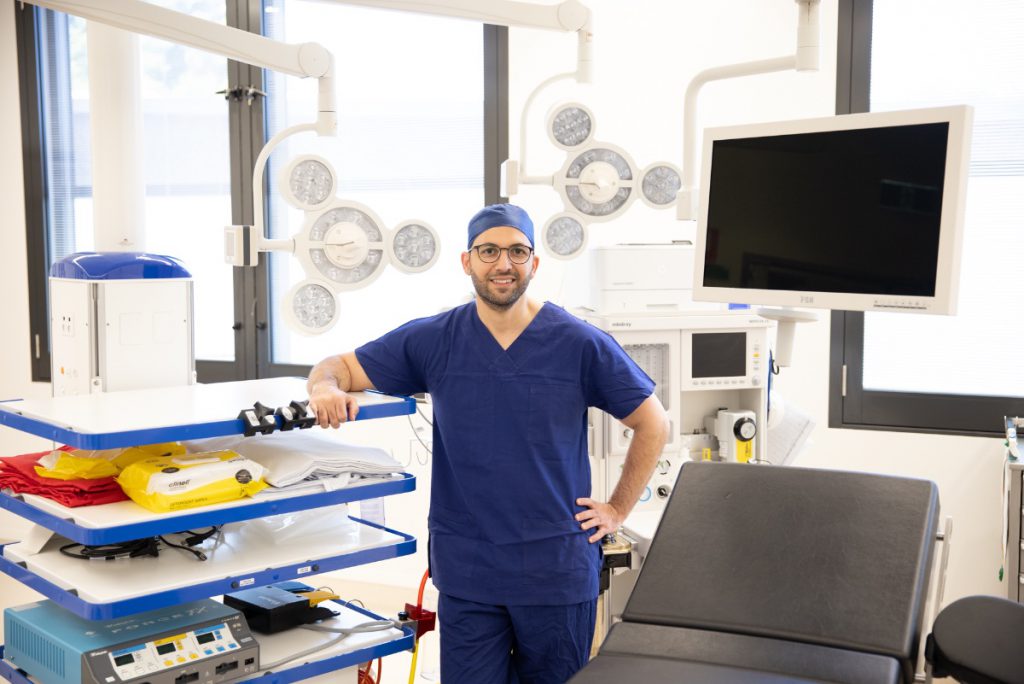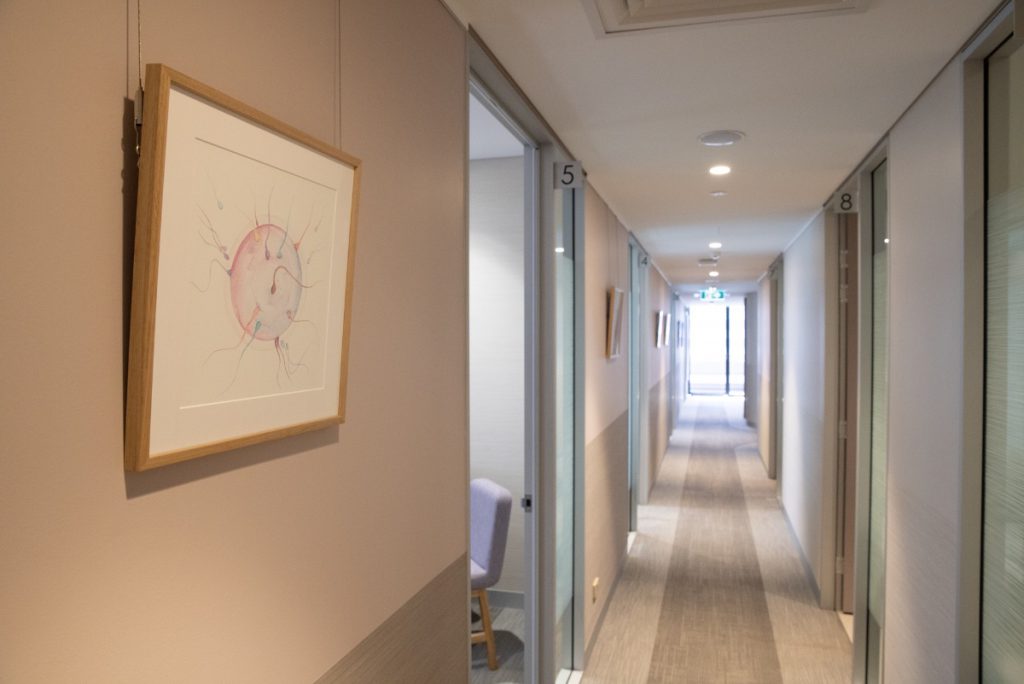Working together to deliver excellent success rates for our patients.
At the core of what we do is help couples fall pregnant. We offer an efficient and effective clinical service to our patients and consult from multiple locations around Sydney.

Dr Shadi Khashaba consults exclusively from numerous IVF Australia locations.
The premier location is the purpose-build Alexandria centre of excellence. This clinic and fertility laboratory offers participating clinicians state-of-the-art facilities to ensure the best environment for the embryo to grow, as well as a full-time, highly experienced team.
Facilities and services available include
Time lapse technology for embryo development & selection
EmbyroScope is an innovative time-lapse technology used to carefully monitor and analyse the development of embryos. It combines an incubator, high resolution camera and computer software to automatically take an image of an embryo up to every 7 minutes.
What are the Benefits of using EmbryoScope?
There are four core benefits to the EmbryoScope:
- Reduced handling: Scientists can review the development of embryos at any point in time without removing them from their incubators.
- More monitoring: Scientists can analyse more than 7200 minutes of an embryos development compared with the standard 6-10 minutes.
- Better embryo selection: By obtaining accurate, in-depth data scientists can now use selection and de-selection criteria to try and identify the best embryo for transfer.
- First video of your baby: If you would like one, you can receive a video of the transferred embryo developing.
Who might benefit from EmbyroScope?
Anyone undergoing IVF or ICSI is suitable for culture in the EmbryoScope.
What is the cost?
There is no additional fee for using the EmbryoScope technology. EmbryoScope is located across all our embyrology laboratories.
More information can be found here on the IVF Australia website.
IVF Australia has developed an artificial intelligence system, called Ivy, to predict the likelihood of a viable pregnancy from transfer of a single embryo in a woman undergoing IVF.
How will Ivy, Artificial Intelligence affect the IVF process?
Ivy can predict how likely an embryo is to develop as far as the stage of having a fetal heart and can thus help the embryologist to select the best embryo for transfer.
What is different from the current IVF process?
Currently, an embryologist uses a standard grading system to assess the appearance of each embryo under the microscope. Different systems had previously been proposed to refine this but, so far, none of them have significantly improved embryo selection.
Ivy artificial intelligence performs a comprehensive assessment of the growth of the embryos over all five days and then relates this data to whether a fetal heart has developed or not. By completely objective analysis of the images, Ivy has taught itself to identify the embryo with the greatest likelihood of developing as far as a fetal heart. The embryo with the highest score, and therefore the highest potential for leading to a viable fetus, can then be selected for transfer.
What are the potential benefits for patients?
The aim of this work is to select the right embryo more quickly so that women going through IVF can conceive more quickly and thus lessen the strain of IVF on them and their families.
More information can be found here on the IVF Australia website.
What is Intracytoplasmic morphologically selected sperm injection (IMSI)?
Intracytoplasmic morphologically selected sperm injection (IMSI) is a technique used in IVF treatment to examine and select sperm using a high-magnification digital imaging microscope for microinjection into the egg.
With the IMSI technique, our scientists are better able to assess the structure of the sperm and exclude the sperm with suspected variations from being injected into the available eggs.
Why perform IMSI?
For men with high numbers of abnormal sperm and previous poor outcomes in IVF with ICSI, an enhanced selection tool may improve likelihood of fertilisation and normal embryo development.
Using digital high-magnification of sperm our scientists can examine the individual sperm at 6,000 times magnification to identify the sperm that exhibit abnormalities and exclude them from being used to fertilise the egg. The sperm that are identified as being structurally normal are then used in the fertilisation procedure using the ICSI method.
In comparison, traditional methods of selecting sperm involve our scientists assessing sperm for any visible abnormalities at 400 times magnification and selecting the most normal looking sperm to microinject into the egg.
Who is IMSI suitable for?
Your Melbourne IVF fertility specialist may recommend IMSI if:
- You have very low numbers of sperm, and
- A high proportion of abnormally shaped sperm, or
- Evidence of poor outcomes with previous ICSI treatments
What is PolScope (Oosight Technology)?
PolScope (or Oosight Technology) is an advanced scientific technique that uses polarised light to study the genetic material in the egg and help identify which eggs may have a better chance of implanting. However, it is important to be aware that there are no randomised trials that suggest that use of PolScope will directly improve the chance of a successful pregnancy from an IVF cycle.
Who is PolScope suitable for?
If you are of advanced maternal age or have had a previous unsuccessful IVF cycle, your fertility specialist may recommend using PolScope on your next cycle.
PolScope may also help with the ICSI process, as the scientist performing the procedure can see where the genetic material is located and avoid injecting through this spindle.
More information can be found here on the IVF Australia website.
What is pre-implantation genetic testing (PGT)?
Pre-implantation Genetic Testing (PGT) is a sophisticated scientific technique which can be used to test embryos for either a specific known single gene condition or chromosome variation.
This enables only chromosomally healthy embryos or those unaffected by a specific disorder to be selected for transfer during an IVF cycle, maximising the chance of a healthy baby.
Up to 70% of embryos created, either via natural conception or IVF do not survive the first 3 months of pregnancy and many don’t achieve implantation because of the previously mentioned reasons.
Who is PGT suitable for?
You may wish to consider pre-implantation genetic testing if you are concerned about any of the following issues:
- Either or both partners are carriers of single gene mutations that you want to avoid passing on to future children
- Either partner has a chromosome rearrangement (called a translocation) that can result in chromosomal variations in the eggs or sperm that could lead to either miscarriage or health problems in the child
- A previous pregnancy has been affected by a chromosomal variation
- Advanced maternal age (usually to test for Down syndrome where the mother is over 38 years old)
- Recurrent miscarriage
- Repeated IVF failure (where 5 or more embryos have been transferred without pregnancy)
What does PGT involve?
In pre-implantation genetic testing, the woman goes through a standard IVF cycle. While the embryos are developing in the IVF laboratory, a few cells are removed from each embryo and tested in one of two ways.
Chromosome testing (Next Generation Sequencing)
The technique of Next Generation Sequencing tests all 24 chromosomes in an embryo to enable the selection and transfer of chromosomally healthy embryos.
Karyomapping
Karyomapping is used if you or your partner are known to be carriers of a serious single gene disorder. Karyomapping can identify which embryos are NOT affected by the disorder preventing the condition from being passed on to the next generation.
More information can be found here on the IVF Australia website.
Hyaluronan, also known as hyaluronic Acid or hyaluronate, is a substance called a glycosaminoglycan which is present within ovarian follicles, the fallopian tube and the uterus. Hyaluronan binds to its receptor, which is present on the lining of the uterus, hence the trade name Embryo Glue™.
It has been shown in several randomised controlled trials that hyaluronan improves pregnancy rates in some couples having an embryo transfer. The trials showing benefit of the addition of hyaluronan have all been in a media (nutrient solution in which embryos are grown) by Vitrolife. The mechanism by which the addition of hyaluronan works is uncertain.
Who is Embryo Glue best suited for?
Using hyaluronan has been shown to benefit couples who are aged over 35 years, those who have poor quality embryos and who have had three unsuccessful embryo transfers (failed implantation).
Are there any risks when using Embryo Glue?
There is no information on birth defects after the use of Embryo Glue™ but several hundred live births have been reported after the use of hyaluronan in culture medium.
Get In Touch
If you have a fertility question or wish to make a booking, please contact us to find a convenient time and date. A GP referral is required.






